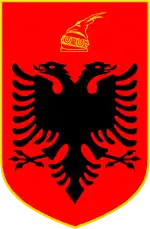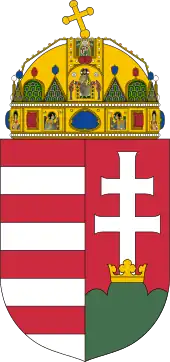Albania–Hungary relations
Albania has an embassy in Budapest and Hungary has an embassy and a consular office in Tirana. The history of diplomatic relations of Albania and Hungary dates back to 1912, when Albania declared its independence on November 28, 1912.
 | |
Albania |
Hungary |
|---|---|
The countries are members of the North Atlantic Treaty Organization and the Organization for Security and Co-operation in Europe. As a European Union (EU) member, Hungary supports Albania in its euro-integration path.[1][2]
History
Both countries experienced Ottoman rule and in some cases rebelled against it, historically including the alliance between John Hunyadi and Gjergj Kastrioti Skanderbeg. In the Great Turkish War, Albanian Catholic leaders Pjetër Bogdani and Toma Raspasani rallied Kosovo Albanian Catholics and Muslims to the pro-Austrian cause.[3] After the Great Turkish War, Hungary was absorbed into the Hapsburg domain, while Albanian inhabited regions remained part of the Ottoman Empire and experienced a period of economic and societal breakdown, which saw large numbers of Catholics from Kosovo flee to north to arrive in Budapest,[3][4] and the widespread Islamization due to extremely steep increases in the poll tax by Ottoman authorities as well as instances of forced conversion.[4][5][6][7] Albanian Catholicism survived in the mountainous Northwest of Albania with significant aid from Austro-Hungarian clerics. Austro-Hungarian funded Catholic schools were the only schools where Albanians were able to study in their native language during Ottoman rule, and as a result many of their students would contribute to the emergence of Albanian nationalism, as did some Hungarian intellectuals such as Franz Nopcsa.
Austria-Hungary was a key proponent of Albanian independence and opposed attempts by Slavic nations to dominate Albanian lands. Austro-Hungarian diplomatic assistance was critical for the expulsion of the Serbian and Montenegrin armies from Durrës and Shkodër in 1912, during the First Balkan War.[8] After Albanian independence, King Zog married a Hungarian woman, Géraldine Apponyi de Nagyappony. In the early 20th century, Albania and Hungary shared a situation where large numbers of Albanians and Hungarians resided outside of their respective new borders, and both saw the rise of irredentist movements that aimed to create Greater Hungary and Greater Albania, but were obstructed by the relative strength of surrounding countries. During World War II, both countries came under the control of Axis-allied regimes, followed by the domination of Communist parties allied to Moscow. Albanian-Hungarian relations came to a halt after the Soviet-Albanian split, but were resuscitated after the fall of Communism.
See also
References
- "Berisha-Kover: PS, jo bojkot". top-channel.tv (in Albanian). 20 March 2012.
- "SZIJJÁRTÓ: HUNGARY FIRMLY SUPPORTS ALBANIA IN EU INTEGRATION EFFORTS". dailynewshungary.com. 19 November 2016.
- Malcolm, Noel (1998). Kosovo: a short history. Macmillan. p. 162. ISBN 978-0-333-66612-8. Retrieved 21 June 2011.
- Pahumi, Nevila (2007). "The Consolidation of Albanian Nationalism". Page 18: "The pasha of Ipek forcibly removed Catholic inhabitants of northern Albania into the plains of southern Serbia after a failed Serb revolt in 1689 and the flight of many Serbs to the Habsburg Empire. The transferred villagers were forced to convert over to Islam."
- Marmullaku, ‘’Albania and the Albanians’’. London: C. Hurst & co., 1975. Page 16.
- Jelavich, Barbara. ‘’History of the Balkans.’’ Cambridge: Cambridge University Press, 1983. Pages 80–81.
- Zhelyazkova, Antonina. ‘’Albanian Identities’’. Page 22
- Britannica, The Editors of Encyclopaedia, ed. (1 October 2021). "Balkan Wars". Encyclopaedia Britannica. Retrieved 28 November 2021.
{{cite encyclopedia}}:|editor-first=has generic name (help)

